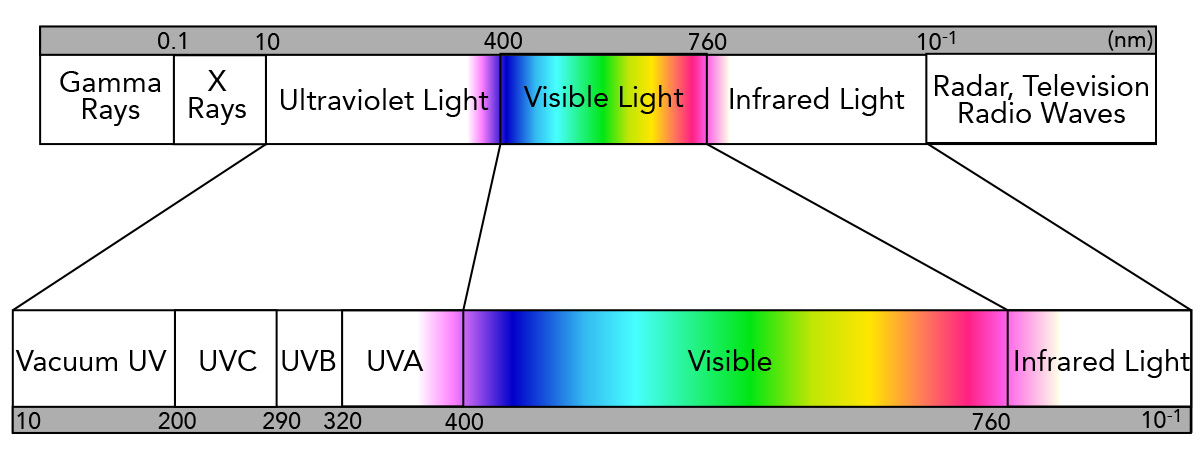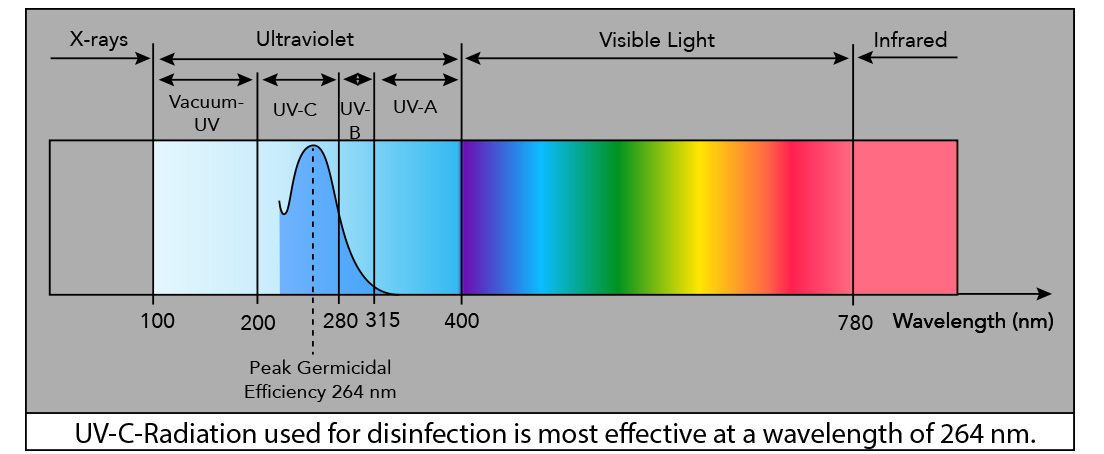The Un-Filters 401 Chapter 2
How UV Works (the technical stuff, sorry)
Ultra Violet radiation is high energy light that lives just past the far end of the visible spectrum, “past the violet”, beyond what’s visible to us and heading in the direction of really high energy X-rays. The UV range is divided into three bands, A, B and C, each corresponding to a wavelength range measured in nanometers (nm), billionths of a meter. As the wavelengths shorten in frequency, the energy they carry goes up. UVA is the highest wavelength range, from 400-315nm, and the least damaging (although all UV light can contribute to skin cancers). UVA is commonly used to attract bugs and make dyes phosphoresce – “black lights” and bug zappers both emit UVA. Higher energy UVB, 315-280nm, has the power to sunburn but also induces melanin production (sun tans) and Vitamin D production in the skin, so it’s critical to our health in low doses. UVC is the really interesting band, with frequencies from 280nm down to 100nm, and here’s why: all DNA, whether ours or bacterial or viral or algal, readily absorbs UVC at two peak wavelengths, at around 265 nanometers and 185nm. UVC at those wavelengths actually causes a deformity in DNA strands at relatively low dosages, and when the DNA strands try to replicate, they create bad copies of themselves, effectively stopping reproduction cold, even if the organism itself survives.

By wonderful coincidence, common low-pressure mercury-vapor lamps emit about 86% of their light at 254nm and the rest at 185nm, perfect for DNA absorption and disruption, and so also perfect for controlling algae and germs. In actuality, most of the useful work is done by the higher frequency light at 254nm, since the quartz glass used in the lamps (and the water itself) absorbs most of the light emitted at the 185nm wavelength. These “UV lamps” operate at around 30% efficiency, so a “40 Watt bulb” might provide about 86% of 30% of 40 Watts, or about 10 Watts of usable UVC light at 254nm, but the light is powerful. By putting the lamp in a watertight sleeve, then running water through a housing to keep it in close contact with the sleeve, the minimum effective exposure rate of 15 microWatts per second per square centimeter is easily attainable and will render algae cells that actually pass through the housing sterile, incapable of reproducing.

Ultra Violet radiation is high energy light that lives just past the far end of the visible spectrum, “past the violet”, beyond what’s visible to us and heading in the direction of really high energy X-rays. The UV range is divided into three bands, A, B and C, each corresponding to a wavelength range measured in nanometers (nm), billionths of a meter. As the wavelengths shorten in frequency, the energy they carry goes up. UVA is the highest wavelength range, from 400-315nm, and the least damaging (although all UV light can contribute to skin cancers). UVA is commonly used to attract bugs and make dyes phosphoresce – “black lights” and bug zappers both emit UVA. Higher energy UVB, 315-280nm, has the power to sunburn but also induces melanin production (sun tans) and Vitamin D production in the skin, so it’s critical to our health in low doses. UVC is the really interesting band, with frequencies from 280nm down to 100nm, and here’s why: all DNA, whether ours or bacterial or viral or algal, readily absorbs UVC at two peak wavelengths, at around 265 nanometers and 185nm. UVC at those wavelengths actually causes a deformity in DNA strands at relatively low dosages, and when the DNA strands try to replicate, they create bad copies of themselves, effectively stopping reproduction cold, even if the organism itself survives.

By wonderful coincidence, common low-pressure mercury-vapor lamps emit about 86% of their light at 254nm and the rest at 185nm, perfect for DNA absorption and disruption, and so also perfect for controlling algae and germs. In actuality, most of the useful work is done by the higher frequency light at 254nm, since the quartz glass used in the lamps (and the water itself) absorbs most of the light emitted at the 185nm wavelength. These “UV lamps” operate at around 30% efficiency, so a “40 Watt bulb” might provide about 86% of 30% of 40 Watts, or about 10 Watts of usable UVC light at 254nm, but the light is powerful. By putting the lamp in a watertight sleeve, then running water through a housing to keep it in close contact with the sleeve, the minimum effective exposure rate of 15 microWatts per second per square centimeter is easily attainable and will render algae cells that actually pass through the housing sterile, incapable of reproducing.





